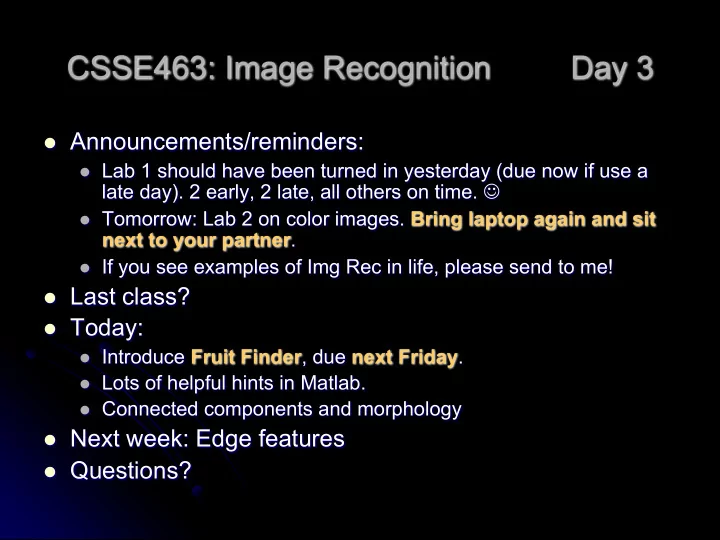

CSSE463: Image Recognition Day 3 l Announcements/reminders: l Lab 1 should have been turned in yesterday (due now if use a late day). 2 early, 2 late, all others on time. J l Tomorrow: Lab 2 on color images. Bring laptop again and sit next to your partner . l If you see examples of Img Rec in life, please send to me! l Last class? l Today: l Introduce Fruit Finder , due next Friday . l Lots of helpful hints in Matlab. l Connected components and morphology l Next week: Edge features l Questions?
Spatial component of color l Break image into parts and describe each one l Can describe each part with moments or histograms l Regular grid l Pros? l Cons? l Image regions l Pros? l Cons? Q9
Additional reading l Color gamuts l http://en.wikipedia.org/wiki/Gamut l Color coherence vectors l Extension of color histograms within local neighborhoods l Used in: l A. Vailaya, H-J Zhang, and A. Jain. On image classification: City images vs. landscapes. Pattern Recognition 31:1921-1936, Dec 1998. l Defined in: l G Pass, R Zabih, and J Miller. Comparing images using color coherence vectors. 4 th ACM Conf. Multimedia, pp 65-73, Boston, 1996. Q10
Project 1: Counting Fruit l How many apples? bananas? oranges?
Why the fruit-finder? l Crash-course in using and applying Matlab l For this reason, I will direct you to some useful functions, but will not give details of all of them l Practice feature extraction l Practice writing a conference-paper style report l Formal and professional! l Use style similar to ICME sunset paper (Abstract, Introduction, Process, Results, …) l Lots of details in specification and rubric. l Warning: The project grade is determined by the paper quality: even a finder that gets 100% accuracy can earn a low grade.
Fruit-finding technique l Observe l What numbers define a banana’s “yellow”? (using imtool pixel zoom) l Model l Can you differentiate between yellow and orange? Orange and red? (Decisions) l Note: this isn’t using a classifier yet; just our best guess at hand- tuned boundaries l Classify pixels using your model (today’s how-to) l “Clean up” the results l Mathematical morphology: today’s discussion! l Write up your results in a professional report (as you go)
Region processing l Binary image analysis l Today, we’ll only consider binary images composed of foreground and background regions l Example: apple and non-apple l Use find to create a mask of which pixels belong to each Q1
Matlab How-to create a mask l Lots of “Random” tidbits that I used in my solution: l zeros l size l find Q2-3
Modifying the mask requires us to define which pixels are neighbors
Neighborhoods l Do we consider diagonals or not? l 4-neighborhood of pixel p: l Consists of pixels in the 4 primary compass directions from p. l 8-neighborhood of pixel p: l Adds 4 pixels in the 4 secondary compass directions from p. Q4-5
Morphological operations (Sonka, ch 13) l Morphology = form and structure (shape) l For binary images l Done via a structuring element (usually a rectangle or circle) l Basic operations: l Dilation, erosion, closing, opening
Dilation l Given a structuring element, adds points in the union of the structuring element and the mask l Intuition: Adds background pixels adjacent to the boundary of the foreground region to the foreground. l Def, for image X and structuring element B: { } Å = Î e = + Î Î 2 X B p : p x b , x X and b B Q7a
Dilation in action Strel = 2x1, centered on dot
Dilation l Matlab: imdilate(bw, structureElt) l Typically want symmetric structuring elements l structureElt (for 8 neighborhood) found by: l structureElt = strel(‘square’, 3); % for erosion using 3x3 neighborhood l structureElt (for 4 neighborhood) found by: l structureElt = strel([0 1 0; 1 1 1; 0 1 0]); l help strel lists 11 others l Demo for intuition: Enlarges a region l Def: { } Å = Î e = + Î Î 2 X B p : p x b , x X and b B Q7a
Erosion l Removes all pixels on the boundary l Matlab: imerode(bw, structureElt) { } Q = Î e = + Î " Î 2 X B p : p x b X b B Q7b
Closing and Opening l Closing (imclose) l Dilate, then erode l Fills internal holes in a region, while maintaining approximate pixel count l Eliminates inlets on the boundary l Opening (imopen) l erode, then dilate l Removes small regions l Eliminates peninsulas on the boundary l To make dilation more aggressive, l Dilate n times, then erode n times. l Or, use a larger structuring element l Example: compare dilating twice using a 3x3 square with dilating once using a 5x5 square .
Connected Components l Goal: to label groups of connected pixels. l Assign each block of foreground pixels a unique integer l 4-connectivity vs. 8-connectivity matters l Matlab help: search for connected components , and use bwlabel function l Demo l I may have you devise an algorithm to do this as part of week 3 take-home test. Q6
Lab 2 l What format? See nice lab 1 l You will work with a partner for each lab l Can stay same or change l I have posted a simpler 10-point grading rubric at the top of each lab l Please ask questions and complete as much as you can in class l Each lab is due the following Weds at the same time as the start of class l Start now!
Recommend
More recommend